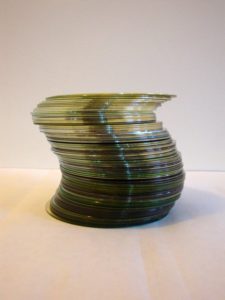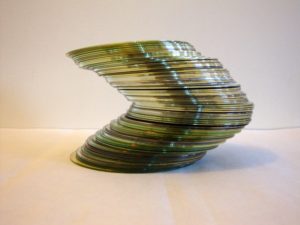CDs and Cavalieri’s Principle: Part 2
After demonstrating Cavalieri’s Principle with empty CD cases, I thought I’d do the same with the actual CDs.
Here we see a bunch of discs stacked up to make a right cylinder.
To compute the volume of this cylinder, it would be sufficient to know (a) the volume of one CD, and (b) the number of CDs in the stack. We would simply multiply the two together to get the volume.
The argument is less obvious, but essentially the same, regardless of how the CDs are stacked! So this “prism”
has the same volume as the original cylinder. Now, this object should also have the same volume
however some center-of-mass issues may foil our elegant mathematical demonstration.
Related Posts



4 Comments
Maria Droujkova · April 18, 2011 at 9:12 am
This is great!
P.S. You should include @MrHonner and possibly #mathchat in your Twitter button 🙂
MrHonner · April 18, 2011 at 9:50 am
Thanks for the advice, Maria, but I don’t think I can customize the Twitter button.
Alexander Bogomolny · November 29, 2011 at 5:45 pm
The center-of-mass issue will not spoil a demonstration if you use a simulation
http://www.cut-the-knot.org/Curriculum/Calculus/Cavalieri.shtml
MrHonner · November 29, 2011 at 5:55 pm
I’m trying to keep this as real-world as possible. When students graduate, enter the workforce, and start stacking CDs in their professional lives, I don’t want them to be surprised by what happens. They can’t learn that from a “simulation”.